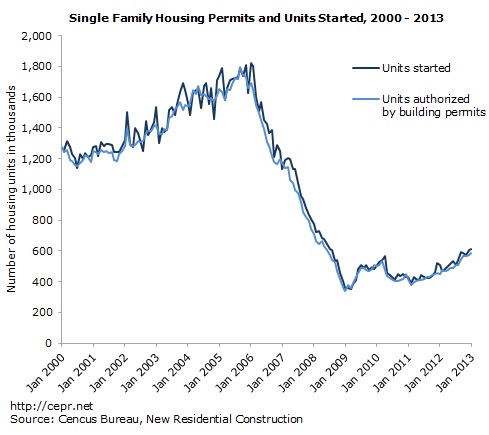February 26, 2013
February 26, 2013 (Housing Market Monitor)
By Dean Baker
Construction will grow at a healthy pace in 2013.
The Case-Shiller 20-City Index rose by 0.9 percent in December, the largest increase in the year. The rise was led by sharp recoveries in many former bubble markets. Las Vegas led the way with a 2.0 percent price increase, followed by Los Angeles with a 1.7 percent price rise, San Francisco with a 1.6 percent rise, Phoenix with a 1.5 percent increase, Minneapolis with a 1.3 percent rise, and San Diego with a 1.1 percent rise.
The December increases continue a pattern of sharply rising prices in these cities that is mostly led by the bottom tier of the market. In Las Vegas prices have risen at a 24.5 percent annual rate over the last quarter, with prices for homes in the bottom third of the market rising at a 42.0 percent rate. In Phoenix prices have risen at an 18.8 percent annual rate, with prices in the bottom tier rising at a 44.6 percent. In San Francisco prices have risen at a 23.8 percent annual rate with prices in the bottom tier rising at a 29.1 percent rate.
The increases have been a bit more balanced in Los Angeles and San Diego. The overall rate of increase in prices in Los Angeles over the last three months was 15.9 percent, compared with 17.9 percent for the bottom tier. In San Diego the overall rate was 18.2 percent, somewhat higher than the 16.4 percent rate for the bottom tier. The explosion in prices at the lower end also hit Atlanta, where they have risen at a 48.0 percent rate over the last quarter.
It is difficult to believe that there is not a substantial element of speculation in this sharp run-up in prices. In several of these cities, most notably Atlanta and Phoenix, the bottom tier of the market had been badly beaten up in the crash. Still, it seems implausible that this sharp of a price rise is reflective of the fundamentals of the market. There has to be a real concern that this is yet another short-term run-up that will end badly for many of those caught up in it.
There is a clear regional pattern to the recovery of the market over the last year. According to the FHFA’s House Price Index, house prices in Arizona rose by 21.6 percent in 2012, by 19.7 percent in Nevada, and 12.0 percent in California. In contrast, prices rose by 2.3 percent in Pennsylvania, 1.3 percent in New York, and just 1.0 percent in Illinois. Prices fell by 0.7 percent in New Jersey in 2012. This divergence is even sharper than what we saw in the peak years of the bubble.
Most other measures of the housing market continue to show improvement. Construction is continuing its upward path, despite the sharp drop in starts reported in January. This decline was clearly a function of weather factors that led to a big jump in starts in December. In the Northeast starts were down 35.3 percent from their December level, but were still above November starts. Starts in the Midwest were down by 50.0 percent, but the vast majority of the decline was due to a plunge in multi-family units. Single-family units were down by just 9.7 percent. Starts in the South and West actually rose in January, as did permits.
We should expect that housing will continue to rise at close to a 10 percent rate over the course of the year. The sector is still operating at a seriously depressed level. However, with vacancy rates still close to record highs, it will be several more years until construction returns to normal levels. And there is no reason to expect that it will return to the boom pace of 2002-2006.
The story with prices is harder to sort out. The rapid price rises in many markets, and especially in the bottom tier of these markets, has to raise serious grounds for concern. These markets fared poorly in the crash, but it is hard to believe that the fundamentals have improved enough to support the price rises that we have seen. There could be more bad times ahead.







